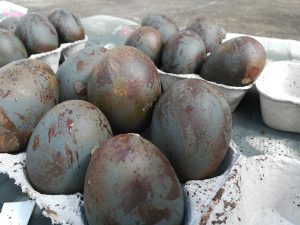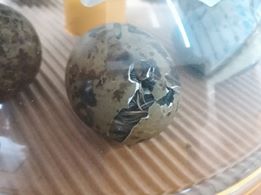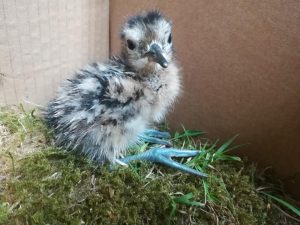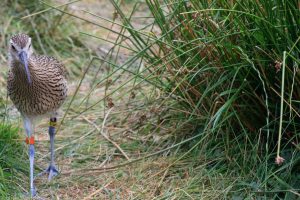Unexpected Duties – Life in the Curlew Country office

My name is Amber Bicheno, and I am currently employed to assist with the Curlew Country project. This is the second year in which I have done this, following on from volunteering work with the Stiperstones and Corndon Hill Landscape Partnership Scheme. In this blog I am going to tell you a little about what I do, and some of the more unusual occurrences in my days at the office.
From the outset this season it was obvious that things would be different to previous years. Headstarting was now our main focus, after a successful trial in 2017 resulted in 5 chicks being reared and released. The time had come to scale this up, and really try to boost curlew numbers to increase their chances.
My role in this is very broad, with administration, publicity and website management being my main focus, but I also assist the project manager with anything she needs. The work I do is highly variable, and often results in strange tasks that could more accurately be described as quests. The ups and downs have been many and I am constantly learning and adapting to suit the project’s needs.

Early in the season I spent time out nest finding, which consists of many hours glued to a pair of binoculars or a telescope watching for birds acting suspiciously. It can take a little bit of practice to get your eye in on what exactly makes a curlew look suspicious, but once you’ve seen it it’s easier to spot again. A bird that is bombing crows or other birds obviously has something to protect, but less obvious behaviours could also indicate a nest is present, such as zig zagging cautiously through a field. I’ve also taken out volunteers, trying to pass on some of my meagre wisdom and work as a team to find nests, to varying degrees of success.
Dummies in Disguise
This is always a tense time for the team, as the race is on to locate nests before the predators get to them. The birds do nothing to help, putting on their very best distracting and disguising techniques. In many cases we would find an incomplete clutch of eggs, which raised the question of taking the egg and adding it to the incubator or leave it until the rest are laid and risk losing them all. To counter this dilemma dummy eggs were introduced, which could be placed into the incomplete nests to encourage the birds to continue laying.

Relating to this came one of my stranger quests; camouflaging eggs to look like curlew eggs. There was some debate as to the best way to achieve this, would chicken eggs be big enough? Maybe not, duck eggs would be closer, painting needed to be dark greens and light browns, would a stencil work? Painting each individually would surely take too long, and we didn’t have the time to spare.
In the end, I went to the market to buy two dozen duck eggs, followed by spray paint in olive green, and a sponge. I then set to work, carefully washing all the eggs, drying, spraying a base coat and sponging on a variety of assorted colours. I wouldn’t call them a work of art, but they would hopefully do a good enough job to convince a curlew to keep laying.
Call the Curlew Midwife
Mid way through the season and all my attention was focused on the incubation of the eggs. This was a learning curve for everyone and involved some frantic reading of the instruction manuals and literature to set them up correctly. The water in the incubators must be kept topped up, to ensure the humidity inside is correct. And two days before hatching, turning is stopped and humidity increased even further to aid with the process.
The eggs can take up to 3 days to hatch, starting with just cracking or crazing on the outside of the shell. This  made for some very tense and stressful watching and waiting, trying hard to resist the urge to help. Helping the chick out of the egg could speed the process along too quickly, resulting in the chick emerging without fully reabsorbing the yolk sack. Care is taken by all to keep the times the incubator is opened to a minimum, each time it’s opened the humidity drops and could make it more difficult for the remaining eggs to hatch.
made for some very tense and stressful watching and waiting, trying hard to resist the urge to help. Helping the chick out of the egg could speed the process along too quickly, resulting in the chick emerging without fully reabsorbing the yolk sack. Care is taken by all to keep the times the incubator is opened to a minimum, each time it’s opened the humidity drops and could make it more difficult for the remaining eggs to hatch.
When first removed from the incubator and placed under a brooder, the chicks beaks had to be dipped in the shallow dish of water available for them, enabling them to find it again. Another issue we had to look out for at this early stage was the chicks getting splayed legs. It is important that they could keep their legs underneath their bodies, but occasionally a chick would start to struggle, with legs angling out uncomfortably. If this occurred we quickly addressed the issue by splinting the legs, using a small elastic band above the knees, no easy task to get on over those very big feet! Once on a close eye had to be kept on the band, to ensure it did not damage the legs and so that it could be removed once they have recovered.
 For the first 48 hours the young chicks do not need to eat, still having enough nutrition from the yolk sac. After this it was a case of encouraging them to eat mini mealworms and chick crumbs, imitating pecking using a pencil until they get the general idea and give it a go themselves. Chick crumbs are generally fed to young chicks of poultry, being small enough and containing the nutrition they require. The mini mealworms are smaller and more manageable for very young chicks than regular mealworms and get them used to moving prey.
For the first 48 hours the young chicks do not need to eat, still having enough nutrition from the yolk sac. After this it was a case of encouraging them to eat mini mealworms and chick crumbs, imitating pecking using a pencil until they get the general idea and give it a go themselves. Chick crumbs are generally fed to young chicks of poultry, being small enough and containing the nutrition they require. The mini mealworms are smaller and more manageable for very young chicks than regular mealworms and get them used to moving prey.
Mountains of Mealworms

The chicks grow fast, and the numbers out from their eggs quickly increased. One weekend whilst I was on duty that I experienced my first loss. I noticed in the final Friday evening check that one chick was calling and staying hidden under the brooder constantly. I removed the chick to a box separate from the others, giving it food and water, but it quickly became apparent that the chick could not properly stand or walk. Uncertain of what to do, and with nobody available to help that weekend I kept the chick separate, keeping a close eye on it for the next couple of days. It started to eat and drink a little, which raised my hopes slightly for the fate of this small creature, but sadly by Sunday afternoon it died. We cannot expect every chick to make it, although I must admit that the loss of this one wrenched at my heart.
For the rest of the chicks all seemed well. As the days went by their appetites increased dramatically, moving onto normal mealworms, giant mealworms, earthworms and morio worms. It is important that the chicks are fed live food, however this presented challenges in itself. The mealworms must be fed and kept cold to prevent them turning into beetles too quickly. The earthworms also have to be kept cool and in earth, so they do not dry out. Morio worms are much bigger versions of mealworms, and much feistier! They will bite if given the chance and proved a bit more of a challenge for our young curlew.

The copious quantities of live food required by the chicks caused some issues when a national mealworm shortage became apparent, after two major suppliers had incidences damaging huge quantities of stock. Cue the team and I frantically visiting every pet store and food suppliers to retrieve more mealworms wherever and whenever possible. I have even spent some time bug hunting in the meadow to boost the number of prey insects.
The Great Outdoors
When the chicks were moved to their outdoor pen, the work did not stop. For welfare to be ensured, regular checks and visits had to made, whilst simultaneously carrying this out as quickly as possible to avoid any imprinting and humanisation of the young birds. The food and water trays are cleaned, disinfected and refilled regularly, to minimise the chances of parasites or diseases. Precautions have been taken to ensure that predators cannot enter the pen, including a double electric fence, a fine gauge wire mesh around the base to stop burrowing and a tough netting over the top. The chick’s safety and wellbeing is of the highest priority.
 All of these combined efforts, strange tasks and odd quests are worth it however, for in the next few weeks the chicks will be released into the wild. It is my hope that all the sleepless nights and visions of mealworms at every corner will be rewarded when that day comes, knowing that we have made every effort to make a difference.
All of these combined efforts, strange tasks and odd quests are worth it however, for in the next few weeks the chicks will be released into the wild. It is my hope that all the sleepless nights and visions of mealworms at every corner will be rewarded when that day comes, knowing that we have made every effort to make a difference.
Headstarting chicks is not a long-term solution to curlew decline, something that all of the Curlew Country team are well aware, but it will buy us time. Time in which wider solutions can be found, and where we can work with farmers to make a real difference.
To find out what you can do to help, click here, or to donate to out curlew appeal click here. Head to our Frequently Asked Questions page for advice on what to do if you have curlew on your land.

